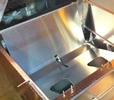


random user submitted photo
Factory Waiex down in Fond Du Lac, WI
30 posts
• Page 3 of 3 • 1, 2, 3
Re: Factory Waiex down in Fond Du Lac, WI
Fantastic news that both pilots will recover well! Thanks for the update.
Building: [11323] Zenith 750 CruzerDuty27.5 / O-320 [Instagram Build Log: Zenith750CruzerSTOL]
N67LJ - Vans RV-9A #90504 (SOLD)
N83LJ - Sonex #0864 (SOLD)
https://rvpilotlife.wordpress.com/blog/home/
N67LJ - Vans RV-9A #90504 (SOLD)
N83LJ - Sonex #0864 (SOLD)
https://rvpilotlife.wordpress.com/blog/home/
-

jjbardell - Posts: 315
- Joined: Wed Feb 25, 2015 5:12 pm
Re: Factory Waiex down in Fond Du Lac, WI
Well that sucks. Good to hear they're going to recover. I flew that plane for my transision training. It was a great little plane.
Glenn
Sonex #600
N889AP
Sonex #600
N889AP
- vwglenn
- Posts: 416
- Joined: Mon Sep 15, 2014 1:00 am
- Location: 6A2 - South of ATL
Re: Factory Waiex down in Fond Du Lac, WI
I'm happy to report that both passengers are out of the hospital. Dave's wife arrived in Appleton tonight and will be driving Dave back to Boston. He is very sore and has some very serious stitches in his left calf and elbow, but he should make a full recovery. I passed along everyone's well-wishes, which seemed to surprise him :-) Dave said he exited the plane immediately after the impact, so he was mobile, but lost a lot of blood and laid on the wing until the first responders arrived (quickly). Dave had nothing but great things to say about how the Sonex staff has helped him these two days. Thanks for everyone's thoughts and prayers.
Mike Smith
Sonex N439M
Scratch built, AeroVee, Dual stick, Tail dragger
http://www.mykitlog.com/mikesmith
Sonex N439M
Scratch built, AeroVee, Dual stick, Tail dragger
http://www.mykitlog.com/mikesmith
- mike.smith
- Posts: 1430
- Joined: Tue Jan 29, 2013 8:45 pm
Re: Factory Waiex down in Fond Du Lac, WI
Glad to see both are doing well and soon to be released. Initial reports with one being airlifted to a second hospital sounded ominous. Hope all continue to have a speedy recovery.
David A.
David A.
- DCASonex
- Posts: 935
- Joined: Mon Sep 12, 2011 8:04 pm
- Location: Western NY USA
Re: Factory Waiex down in Fond Du Lac, WI
Hi all,
Glad to hear both pilots doing well. My father flew that plane for his transition training too, he said it flew well and the engine ran well. He said it had an aerovee. Kudos to sonex staff for all their help to the pilots. Its too bad, after a fun week, to have this thrown on them.
WaiexN143NM
Michael
Glad to hear both pilots doing well. My father flew that plane for his transition training too, he said it flew well and the engine ran well. He said it had an aerovee. Kudos to sonex staff for all their help to the pilots. Its too bad, after a fun week, to have this thrown on them.
WaiexN143NM
Michael
- WaiexN143NM
- Posts: 1206
- Joined: Mon Sep 15, 2014 1:04 am
- Location: palm springs CA
Re: Factory Waiex down in Fond Du Lac, WI
Hi all,
Accident report w photos on www.kathrynsreport.com aug 3 . Godspeed to tom and dave.
WaiexN143NM
Michael
Accident report w photos on www.kathrynsreport.com aug 3 . Godspeed to tom and dave.
WaiexN143NM
Michael
- WaiexN143NM
- Posts: 1206
- Joined: Mon Sep 15, 2014 1:04 am
- Location: palm springs CA
Re: Factory Waiex down in Fond Du Lac, WI
Given what seems to have happened, and how bad it could have been for the occupants -- that's one strong little airframe!
Ihab
Ihab
Ihab Awad, San Jose, CA
- ihab
- Posts: 159
- Joined: Sat Mar 09, 2013 1:45 pm
- Location: San Jose, CA (KRHV)
Re: Factory Waiex down in Fond Du Lac, WI
Terry posted this on a recent turbocharger thread:
viewtopic.php?f=7&t=3561&p=31050#p31050
The part that stands out to me is that the engine compression dropped from over 75/80 to less than 20/80 between a 100 hour inspection on February 9, 2016 and the accident on August 3, 2016. I couldn't find the actual number of hours elapsed since the inspection, but it should be less than 100 and I suspect much less. It doesn't seem normal to lose that much compression in such a short span of time. I wish the report provided pictures. I would not have expected a valve that isn't burned through to have resulted in that large of a power loss. Was a valve sticking? Was the actual problem something else and the low compression is a coincidence?
I have become suspicious of my compression, so I check the compression by feel before and after every flight. I've had one consistently low for a few months so I removed the head and had to cut the valve seat due to pitting. I ended up replacing the other exhaust valve too because it wasn't looking good either.
I've never seen anything official about how often valve work is required or even how it should be performed. What type of valve seat cutter? Three angle? Dimensions of the cut? Anecdotally, it seems to be a common maintenance item mentioned on the forum. Is there anyone out there quietly running hundreds of hours without performing a top overhaul? Maybe having a second set of heads in reserve or owing your own valve seat cutters is just part of owning an Aerovee?
It's 2017, we're living in the future, surely someone knows why valves don't last long on an Aerovee. Is there a better valve material that could be used? Are Great Plains or Revmaster heads any better? The pictures I see on the internet don't really look any different--I suspect they all share the same supplier. I'd gladly pay much more if I knew random exhaust valve issues wouldn't spring up on me.
All, FYI,
The NTSB investigation docket for the N12YX incident was updated & released to the public on December 11, 2017.
For interesting reading, see the N12YX National Transportation Safety Board Aviation Accident Factual Report, found here:
https://app.ntsb.gov/pdfgenerator/ReportGeneratorFile.ashx?EventID=20160803X52340&AKey=1&RType=Final&IType=LA
…and also the file titled “Record of conversation – FAA Inspector, which can be downloaded from the NTSB docket database, found here:
https://dms.ntsb.gov/pubdms/search/hitlist.cfm?docketID=60642&CFID=1418921&CFTOKEN=e2f2fefa54968de-5336D864-CCA2-7DEA-F00165B51F5993CC
viewtopic.php?f=7&t=3561&p=31050#p31050
The part that stands out to me is that the engine compression dropped from over 75/80 to less than 20/80 between a 100 hour inspection on February 9, 2016 and the accident on August 3, 2016. I couldn't find the actual number of hours elapsed since the inspection, but it should be less than 100 and I suspect much less. It doesn't seem normal to lose that much compression in such a short span of time. I wish the report provided pictures. I would not have expected a valve that isn't burned through to have resulted in that large of a power loss. Was a valve sticking? Was the actual problem something else and the low compression is a coincidence?
I have become suspicious of my compression, so I check the compression by feel before and after every flight. I've had one consistently low for a few months so I removed the head and had to cut the valve seat due to pitting. I ended up replacing the other exhaust valve too because it wasn't looking good either.
I've never seen anything official about how often valve work is required or even how it should be performed. What type of valve seat cutter? Three angle? Dimensions of the cut? Anecdotally, it seems to be a common maintenance item mentioned on the forum. Is there anyone out there quietly running hundreds of hours without performing a top overhaul? Maybe having a second set of heads in reserve or owing your own valve seat cutters is just part of owning an Aerovee?
It's 2017, we're living in the future, surely someone knows why valves don't last long on an Aerovee. Is there a better valve material that could be used? Are Great Plains or Revmaster heads any better? The pictures I see on the internet don't really look any different--I suspect they all share the same supplier. I'd gladly pay much more if I knew random exhaust valve issues wouldn't spring up on me.
- gammaxy
- Posts: 601
- Joined: Wed Sep 04, 2013 9:31 am
Re: Factory Waiex down in Fond Du Lac, WI
I’ve found the valves only need doing when the heads have been hot. How do I know this ? I’ve refaced the exhaust valve seats about 3 x times on two different engines. I do my absolute best to never let my heads get over 380 or 390 ever from now on. I’m doing well so far and don’t have a weak cyl when turning over the engine before each flight. I can’t help but wonder if the factory plane had someone fly it that flight possibly and roast them ? Not sure. Whenever I read about first flights and read the temps go through the roof I wonder how long till they will have valve issues. It’s almost like you need to do all the cooling mods like opening up the cowling exit first before that flight. Either that or just replace the heads and rings once you have got the temps sorted then probably a reliable Aerovee you’ll have.
Sonex 1645
VH-VWS
Tailwheel
Former Aerovee Turbo
Rotax 912
VH-VWS
Tailwheel
Former Aerovee Turbo
Rotax 912
- Brett
- Posts: 269
- Joined: Tue Apr 08, 2014 3:49 am
- Location: Geraldton W.A Australia
Re: Factory Waiex down in Fond Du Lac, WI
After 16 months, only a factual report and no conclusions? I know the FAA is slow, but that borders on ridiculous.
Mike Smith
Sonex N439M
Scratch built, AeroVee, Dual stick, Tail dragger
http://www.mykitlog.com/mikesmith
Sonex N439M
Scratch built, AeroVee, Dual stick, Tail dragger
http://www.mykitlog.com/mikesmith
- mike.smith
- Posts: 1430
- Joined: Tue Jan 29, 2013 8:45 pm
30 posts
• Page 3 of 3 • 1, 2, 3
Who is online
Users browsing this forum: No registered users and 71 guests







